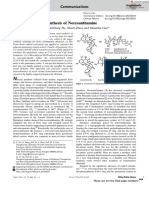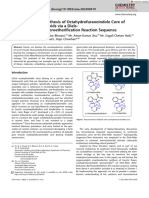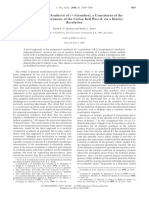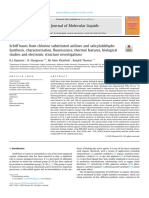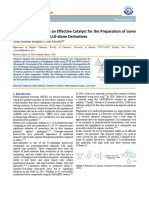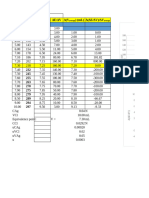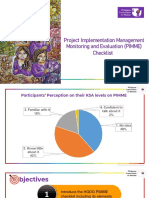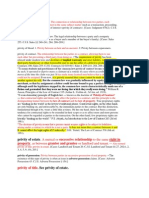Mikanokryptin
Mikanokryptin
Uploaded by
Kiệt LýCopyright:
Available Formats
Mikanokryptin
Mikanokryptin
Uploaded by
Kiệt LýOriginal Title
Copyright
Available Formats
Share this document
Did you find this document useful?
Is this content inappropriate?
Copyright:
Available Formats
Mikanokryptin
Mikanokryptin
Uploaded by
Kiệt LýCopyright:
Available Formats
Angewandte
Communications Chemie
International Edition: DOI: 10.1002/anie.201611078
Natural Products Synthesis German Edition: DOI: 10.1002/ange.201611078
A Double Allylation Strategy for Gram-Scale Guaianolide Production:
Total Synthesis of (+)-Mikanokryptin
Xirui Hu, Silong Xu, and Thomas J. Maimone*
Abstract: With over 5000 members isolated to date, sesquiter-
pene lactones represent a prolific source of medicinal agents
with several derivatives in human clinical trials. The guaiano-
lides, a major subset of this group, have been intensely
investigated from both medicinal and chemical-synthesis
perspectives for decades. To date, the myriad stereochemical
permutations presented by this enormous family have pre-
cluded the synthesis of many unique members. Herein we
report the total synthesis of the trans-fused 8,12-guaianolide
(+)-mikanokryptin in 10 steps from (+)-carvone. Notably, this
synthesis is the first gram-scale total synthesis of a guaianolide
natural product.
Sesquiterpene lactones from the Asteraceae family of plants
represent one of the largest and most biologically significant
classes of plant secondary metabolites.[1] Their presence in
both traditional herbal medicine regimes as well as modern
human medicine have been extensively documented.[1, 2] In
particular, a-methylene-g-lactone-containing members have
strong documented anticancer,[3] anti-inflammatory,[4] anthel-
mintic,[5] and antimigraine activity.[6] Multiple members have
also been shown to inhibit aspects of the NF-kB signaling
pathway,[7] a central mediator of the human immune response
whose deregulation is noted in inflammatory and auto-
immune diseases as well as various human cancers.[8]
The 5,7-fused bicyclic family of guaianolides is perhaps
the flagship subset of sesquiterpene lactone natural products
and two major, isomeric subtypes, the 6,12-guaianolides and
8,12-guaianolides, have been isolated (Scheme 1 A). Despite
extensive studies on the chemical synthesis of 6,12-guaiano-
lides,[9] 8,12-guaianolides have received relatively limited Scheme 1. A) Guaianolide ring systems and various members of the
attention from the synthetic community.[10] Mikanokryptin 8,12-guaianolide family. B) A double allylation disconnection to access
8,12-guaianolides from simple precursors.
(1), isolated in 1975 by Herz and co-workers, belongs to the
continually growing family of trans-fused 8,12-guaianolides,
which are largely unexplored and present stereochemistry
patterns not readily addressed by current strategies (Sche- two simple, hypothetical fragments 3 and 4 (Scheme 1 B). Of
me 1 A).[11] In developing a synthetic route to this family, we significant concern to us was the paucity of examples of seven-
viewed a double allylation disconnection as potentially membered-ring formation by metal-mediated intramolecular
capable of constructing the guaianolide ring system 2 from Barbier-type allylation relevant to this synthetic problem.[12, 13]
Herein we disclose the realization of this plan. Our straight-
forward total synthesis of 1 is suitable for the formation of
[*] X. Hu, Prof. Dr. S. Xu, Prof. Dr. T. J. Maimone multigram quantities of advanced intermediates and a gram
Department of Chemistry, University of California, Berkeley of the natural product in a single synthetic pass.
826 Latimer Hall, Berkeley, CA 94720 (USA)
Our studies began with the construction of a precursor to
E-mail: maimone@berkeley.edu
intermediate 3, for which we turned to the chiral pool of
Prof. Dr. S. Xu
Current address: Department of Chemistry, School of Science terpenes. For the past several decades, limonene,[14] isopule-
Xi’an Jiaotong University, Xi’an, 710049 (P.R. China) gol,[15] and carvone[16] have found broad application in the
Supporting information and the ORCID identification number(s) for synthesis of guaianane sesquiterpenes, among which carvone
the author(s) of this article can be found under http://dx.doi.org/10. is of particular utility for the synthesis of guaianolides with
1002/anie.201611078. oxidation at C3. Favorskii-type ring contractions have fea-
Angew. Chem. Int. Ed. 2017, 56, 1 – 6 ! 2017 Wiley-VCH Verlag GmbH & Co. KGaA, Weinheim 1
!
!
These are not the final page numbers!
Angewandte
Communications Chemie
Scheme 2. Gram-scale total synthesis of (+)-mikanokryptin (1). Reagents and conditions: a) carvone (1 equiv), Na2CO3 (3 equiv), SO2Cl2 (1.2 equiv, added
slowly over 2 h), DCM, 0 8C, then CeCl3·7 H2O (1.1 equiv), NaBH4 (3 equiv), MeOH, 0 8C, 1 h, 78 %; b) TBDPSCl (1.2 equiv), imidazole (3 equiv), DMAP
(0.05 equiv), DMF, room temperature, 8 h, 90 %; c) O3, pyridine (0.3 equiv), DCM, !78 8C, 20–40 min, then DMS (2 equiv), room temperature, 8 h, then
piperidine (0.15 equiv), AcOH (0.2 equiv), 40 8C, 16 h, 42 %; d) In (1.5 equiv), 7 (1.2 equiv), 8 (1 equiv), H2O (1 equiv), DMF, room temperature, 8 h, 67 %,
d.r. 2:1; e) TESOTf (4 equiv), 2,4,6-collidine (6 equiv), DCM, 0 8C, 24 h, 78 %; f) SnCl2 (4.5 equiv), NaI (9 equiv), DMF, 60 8C, 12 h, 90 %; g) NaOMe
(0.1 equiv), MeOH, 16 h, then AcOH (0.1 equiv), PtO2 (0.1 equiv), H2 (1 atm), 6 h, 96 %; h) [Rh(PPh3)3Cl] (0.1 equiv), H2 (1 atm), PhH, 1 h, 54 %; i) TBAF
(3 equiv), THF, room temperature, 24 h; DBU (1.1 equiv), toluene, DCM, D, 69 %; j) MnO2, DCM, room temperature, 16 h, 97 %. DBU = 1,8-diazabicyclo-
[5.4.0]undec-7-ene, DCM = dichloromethane, DMAP = 4-dimethylaminopyridine, DMF = N,N-dimethylformamide, DMS = dimethyl sulfide, TBDPSCl = tert-
butyldiphenylsilyl chloride, TESOTf = triethylsilyl trifluoromethanesulfonate, TBAF = tetra-n-butylammonium fluoride. All X-ray crystal structures shown were
obtained during preliminary studies conducted with (!)-carvone.
tured prominently in this regard, and typical result in related 8,12-guianolides (Scheme 1), a cis arrangement
cyclopentane-containing building blocks in 5–8 synthetic between the C6 hydroxy group and the neighboring acrylate
steps.[13a,c–g, 16a–d] Considering the desire for D4,5 unsaturation, group is required on the future cycloheptane ring. Although
we developed a robust three-step protocol from carvone guaianolides with a trans arrangement of these groups have
(Scheme 2). The isopropenyl group of carvone was first been studied (see geigerin, for example, Scheme 1 A),[10b–d]
chlorinated at the allylic position (SO2Cl2, Na2CO3), and then fewer tactics exist to access this pattern and sometimes rely on
directly subjected to the Luche reduction conditions. This the inversion or epimerization of a trans-configured precur-
one-pot procedure afforded chloro-substituted cis-carveol 5 sor.[19] We were pleased to find that allylic bromide 8, which
reliably on a 30 g scale in approximately 80 % yield. Silylation can be prepared in two steps from commercially available
of 5 with tert-butyldiphenylsilyl chloride cleanly provided silyl materials on a decagram scale, functioned well in this
ether 6 in excellent yield (> 90 %). Inspired by previous work setting.[20, 21] Under indium-mediated conditions, 8 could be
with limonene,[17] ozonolysis of 6 in the presence of catalytic chemoselectively activated in the presence of allylic chloride
quantities of pyridine (0.3 equiv) resulted in chemoselective 7, and was found to cleanly add to the aldehyde moiety to give
cleavage of the trisubstituted olefin under carefully moni- 9 (d.r. 2:1 at C6) in 67 % yield on a 14 g scale. Allylation
tored cryogenic conditions.[18] The sensitive dicarbonyl inter- protocols based on activation with Cr, Zn, Pd, Cd, Sn, Pb, and
mediate thus formed following reductive quenching with Bi were found to be inferior with respect to both yield and
dimethyl sulfide underwent intramolecular aldol condensa- diastereoselectivity.[22] Notably, the incorporation of 1 equiv-
tion in the presence of piperidine and acetic acid to afford alent of H2O proved important; without it, slightly lower
enal 7 in a one-pot procedure. Large quantities of 7 (ca. 100 g) diastereoselectivity was observed as well as extensive in situ
were readily prepared in our laboratory through this three- formation of the 6,12-lactone framework. With larger quanti-
step procedure, which is envisioned to serve as the foundation ties, increased decomposition of 8 was observed. The sensitive
for syntheses of numerous guaianolides with D4,5 unsatura- homoallylic alcohol 9 and the minor diastereomer were then
tion. subjected to the mild deacetalization protocol reported by
With the western fragment completed, we turned toward Fujioka, Kita, and co-workers (TESOTf, 2,4,6-collidine),[23]
the first of two allylation reactions. For mikanokryptin (1) and
2 www.angewandte.org ! 2017 Wiley-VCH Verlag GmbH & Co. KGaA, Weinheim Angew. Chem. Int. Ed. 2017, 56, 1 – 6
!
!
These are not the final page numbers!
Angewandte
Communications Chemie
which also silylated the C6 alcohol, thus leading to 10.[24] At cyclized product was obtained. When all reagents (SnCl2, NaI,
this stage, the minor diastereomer could also be separated. and 10) were simply mixed together and heated in a single
With substrate 10 accessible on large scales, we were well- step (entry 8), a remarkably clean reaction ensued at 60 8C to
positioned to evaluate the second, seven-membered-ring- afford 11 in 90 % yield as a single diastereomer. Notably, this
forming allylation reaction (Table 1). We commenced our reaction was performed on a 7 g scale without a depression in
yield.
With a six-step, multigram-scale synthesis of the full
Table 1: Investigation of metal-mediated allylation conditions for the
synthesis of the 5,7,5-fused guaianolide lactone system. guaianolide skeleton complete, only redox manipulations
were required to complete the target. Chemoselective reduc-
tion of the D10,14 alkene in 11 proved challenging in the
presence of the more reactive a-methylenelactone. In the
presence of the Wilkinson catalyst, only the latter was
reduced to give 13 (Scheme 2). With PtO2/H2, both olefins
could be readily hydrogenated. Taking advantage of the high
reactivity of the a-methylenelactone toward conjugate addi-
Entry Conditions[a] Yield [%][b] tion, we first treated 11 with a catalytic quantity of sodium
11 14 15 rsm[c]
methoxide (10 mol %) in MeOH, and then reduced the
1 CrCl2, cat. NiCl2, DMF, 60 8C 10[d] 17 – – methanol addition product with the Adam catalyst (PtO2,
2 In0, NaI, DMF, 60 8C 13[e] – – – AcOH, H2) in near quantitative yield (96 %) in the same flask.
3[f ] NaI; SmI2, HMPA–THF, !78 8C 27[d] 17 – –
When attempting the global desilylation of 12 (TBAF, THF),
4[f ] NaI; Zn0, aq. NH4Cl, THF, rt 0 51 – 34
5[f ] NaI; Mg0, cat. (CH2Br)2, THF, rt 0 – – –
we noticed that a base-mediated retro-conjugate addition of
6[f ] NaI; iPrMgCl, THF, 0 8C 0 – – – MeOH occurred, thus resulting in a 5:2 mixture of the
7[f ] NaI; SnCl2, DMF, rt 53[e] – 20 9 deprotected conjugated ester and the methanol adduct in
8[g] SnCl2, NaI, DMF, 60 8C 90[e] – – – 83 % yield. When DBU was added to the crude mixture, the
[a] Reactions were performed on a 30 mg scale unless otherwise stated. reaction could be pushed to completion in favor of the
[b] Yield of the isolated product. [c] Recovered starting material. conjugated ester product; thus, the ester was isolated in 69 %
[d] Diastereomeric ratio: 11/8-epi-11 2:1. [e] A single diastereomer was yield on a gram scale. Finally, the addition of freshly activated
obtained. [f] The starting material was first treated with NaI in acetone MnO2 provided mikanokryptin (1) in near-quantitative yield
for 8 h. [g] The reaction was performed on a 7 g scale. through highly chemoselective allylic oxidation. Notably, one
gram of 1 was synthesized in a single pass from (+)-carvone in
6 % overall yield. The absolute configuration of 1 was
confirmed as previously reported (synthetic: [a]D =+ 235.08,
natural: [a]D =+ 2648 (c = 0.098, MeOH)). Moreover, it is
envisioned that intermediate 11, readily accessible in multi-
gram quantities, could serve as a versatile intermediate for the
synthesis of guaianolides containing both D4,5 and D10,14
functionalization.[27]
investigation by exploring the venerable Nozaki–Hiyama– In summary, we have completed a short, enantiospecific,
Kishi (NHK) reaction (entry 1), which has proven efficient in gram-scale total synthesis of mikanokryptin, a complex 8,12-
many syntheses of medium-sized rings.[22a] The desired trans- guaianolide. Although guaianolides have been the subject of
formation proceeded in low yield (10 %) and with moderate numerous synthetic campaigns, most total synthetic routes to
diastereoselectivity (d.r. 2:1). Surprisingly, the major products date have produced low-milligram quantities of material.[28]
formed in this reaction were a mixture of two diastereomeric To the best of our knowledge, this approach represents the
cyclooctanes 14. This competition (eight- versus seven- first gram-scale, fully synthetic entry into this coveted
membered-ring formation) was also observed under sama- sesquiterpene family. Two highly robust and scalable allyla-
rium iodide mediated cyclization conditions with an allylic tion processes were critical in processing large quantities of
iodide substrate, although in this case the formation of the material. Through variations on this strategy, the synthesis of
seven-membered ring to give 11 prevailed slightly (entry 3).[25] other mikanokryptin-type 8,12-guaianolides should be possi-
In contrast, indium- and zinc-mediated conditions were more ble. Such endeavors, in addition to the exploration of
selective for a single product (entries 2 and 4). In the former alternative reagent-controlled allylation methods to enable
case, 11 was afforded as a single diastereomer (13 %), whereas the synthesis of all guaianolide stereochemical patterns, are
the latter produced 14 (51 %), and recovered 10 (34 %). currently under way and will be reported in due course.
Magnesium-based conditions were ineffective for this trans-
formation (entries 5 and 6). Gratifyingly, tin(II) chloride
proved to be a superior reductant.[22h, 26] Finkelstein conver- Acknowledgements
sion of 10 into an allylic iodide, followed by SnCl2-mediated
cyclization, afforded synthetically useful quantities of 11 This research was supported by the NIH (GM116952). T.J.M.
(53 %), along with the recovery of 10, and cycloheptanol 15 is an Alfred P. Sloan Fellow and Cottrel Scholar. Bristol-
(Table 1, entry 7). Notably, only one diastereomer of each Myers Squibb, Amgen, and the UC Berkeley Graduate
Angew. Chem. Int. Ed. 2017, 56, 1 – 6 ! 2017 Wiley-VCH Verlag GmbH & Co. KGaA, Weinheim www.angewandte.org 3
!
!
These are not the final page numbers!
Angewandte
Communications Chemie
Division are acknowledged for providing predoctoral fellow- 1975, 14, 1664; c) W. F. Reynolds, R. G. Enriquez, M. A. Chavez,
ships to X.H. S.X. thanks the National Natural Science A. L. Silba, M. A. Martinez, Can. J. Chem. 1985, 63, 849; d) M. J.
Foundation of China (No. 21402149) and the Chinese Bovill, M. H. P. Guy, G. A. Sim, D. N. J. White, W. Herz, J. Chem.
Soc. Perkin Trans. 2 1979, 53.
Scholarship Council (CSC) fellowship program. We thank
[12] a) V. J. Bryan, T. H. Chan, Tetrahedron Lett. 1996, 37, 5341;
Dr. Hasan Celik and Yujia Tao for NMR spectroscopic b) G. A. Molander, J. B. Etter, P. W. Zinke, J. Am. Chem. Soc.
assistance and technical assistance, respectively. Dr. Antonio 1987, 109, 453; c) G. A. Molander, J. A. McKie, J. Org. Chem.
DiPasquale is thanked for X-ray crystallographic analysis, for 1991, 56, 4112; d) L. M. Fleury, A. D. Kosal, J. T. Masters, B. L.
which support from NIH Shared Instrument Grant S10- Ashfeld, J. Org. Chem. 2013, 78, 253.
RR027172 is acknowledged. [13] For single allylation events in guaianolide synthesis, see: a) T. G.
Elford, D. G. Hall, J. Am. Chem. Soc. 2010, 132, 1488; b) S.
Kalidindi, W. B. Jeong, A. Schall, R. Bandichhor, B. Nosee, O.
Reiser, Angew. Chem. Int. Ed. 2007, 46, 6361; Angew. Chem.
Conflict of interest 2007, 119, 6478; c) H. S. Yang, X. X. Qiao, F. Y. Li, H. Ma, L. G.
Xie, X. Xu, Tetrahedron Lett. 2009, 50, 1110; d) H. Yang, Y. Gao,
The authors declare no conflict of interest. X. Qiao, L. Xie, X. Xu, Org. Lett. 2011, 13, 3670; e) B. Wen, J. K.
Hexum, J. C. Widen, D. A. Harki, K. M. Brummond, Org. Lett.
Keywords: allylation · guaianolides · natural products · 2013, 15, 2644; f) S. V. Ley, A. Antonello, E. P. Balskus, D. T.
terpenes · total synthesis Booth, S. B. Christensen, E. Cleator, H. Gold, K. Hogenauer, U.
Hunger, R. M. Myers, S. F. Oliver, O. Simic, M. D. Smith, H.
Sohoel, A. J. Woolford, Proc. Natl. Acad. Sci. USA 2004, 101,
12073; g) S. P. Andrews, M. Ball, F. Wierschem, E. Cleator, S.
Oliver, K. Hçgenauer, O. Simic, A. Antonello, U. H"nger, M. D.
Smith, S. V. Ley, Chem. Eur. J. 2007, 13, 5688.
[1] B. Ivanescu, A. Miron, A. Corciova, J. Anal. Methods Chem.
[14] a) A. Srikrishna, V. H. Pardeshi, G. Satyanarayana, Tetrahedron:
2015, 2015, 247685.
Asymmetry 2010, 21, 746; b) A. Srikrishna, V. H. Pardeshi,
[2] a) M. Chadwick, H. Trewin, F. Gawthrop, C. Wagstaff, Int. J.
Tetrahedron 2010, 66, 8160; c) E. L. Grimm, J. L. Methot, M.
Mol. Sci. 2013, 14, 12780; b) G. F. Padilla-Gonzalez, F. A.
Shamji, Pure Appl. Chem. 2003, 75, 231.
dos Santos, F. B. Da Costa, Crit. Rev. Plant Sci. 2016, 35, 18.
[15] M. Zahel, A. Kessberg, P. Metz, Angew. Chem. Int. Ed. 2013, 52,
[3] a) S. Zhang, Y. K. Won, C. N. Ong, H. M. Shen, Curr. Med.
5390; Angew. Chem. 2013, 125, 5500.
Chem. Anticancer Agents 2005, 5, 239; b) A. Janecka, A.
[16] a) E. Lee, J. W. Lim, C. H. Yoon, Y. S. Sung, Y. K. Kim, M. Yun,
Wyre˛bska, K. Gach, J. Fichna, T. Janecki, Drug Discovery
S. Kim, J. Am. Chem. Soc. 1997, 119, 8391; b) V. Navickas, D. B.
Today 2012, 17, 561.
Ushakov, M. E. Maier, M. Strobele, H. J. Meyer, Org. Lett. 2010,
[4] a) I. Merfort, Curr. Drug Targets 2011, 12, 1560; b) I. H. Hall,
K. H. Lee, C. O. Starnes, Y. Sumida, R. Y. Wu, T. G. Waddell, 12, 3418; c) L. Z. Sun, F. Shah, M. A. Helal, Y. S. Wu, Y. Pedduri,
J. W. Cochran, K. G. Gerhart, J. Pharm. Sci. 1979, 68, 537. A. G. Chittiboyina, J. Gut, P. J. Rosenthal, M. A. Avery, J. Med.
[5] a) L. G. Rocha, J. R. Almeida, R. O. Macedo, J. M. Barbosa- Chem. 2010, 53, 7864; d) T. C. Johnson, M. R. Chin, T. Han, J. P.
Filho, Phytomedicine 2005, 12, 514; b) H. Fuchino, T. Koide, M. Shen, T. Rana, D. Siegel, J. Am. Chem. Soc. 2016, 138, 6068;
Takahashi, S. Sekita, M. Satake, Planta Med. 2001, 67, 647. e) F. L. Manzano, F. M. Guerra, F. J. Moreno-Dorado, Z. D.
[6] a) J. J. Ross, J. T. Arnason, H. C. Birnboim, Planta Med. 1999, 65, Jorge, G. M. Massanet, Org. Lett. 2006, 8, 2879; f) R. Mar!n-
126; b) R. J. Marles, J. Kaminski, J. T. Arnason, L. Pazos-Sanou, Barrios, A. L. Garc!a-Cabeza, F. J. Moreno-Dorado, F. M.
S. Heptinstall, N. H. Fischer, C. W. Crompton, D. G. Kindack, Guerra, G. M. Massanet, J. Org. Chem. 2014, 79, 6501.
D. V. Awang, J. Nat. Prod. 1992, 55, 1044. [17] a) A. Srikrishna, N. C. Babu, Tetrahedron Lett. 2001, 42, 4913;
[7] B. Siedle, A. J. Garc!a-PiÇeres, R. Murillo, J. Schulte-Mçnting, V. b) D. S. Pisoni, D. B. Silva, R. A. Schenato, M. A. Ceschi, J. Braz.
Castro, P. R"ngeler, C. A. Klaas, F. B. Da Costa, W. Kisiel, I. Chem. Soc. 2004, 15, 652.
Merfort, J. Med. Chem. 2004, 47, 6042. [18] Extensive undesired oxidation of the isopropenyl unit was
[8] a) M. R. O. Kreuger, S. Grootjans, M. W. Biavatti, P. Vandena- observed under prolonged reaction times or in the absence of
beele, K. D#Herde, Anti-Cancer Drugs 2012, 23, 883; b) M. M. pyridine.
Chaturvedi, B. Sung, V. R. Yadav, R. Kannappan, B. B. Aggar- [19] For examples, see: a) A. E. Greene, M. T. Edgar, J. Org. Chem.
wal, Oncogene 2011, 30, 1615. 1989, 54, 1468; b) A. Lauridsen, C. Cornett, T. Vulpius, P. Moldt,
[9] For a recent review of guaianolide syntheses, see: A. Santana, S. B. Christensen, Acta Chem. Scand. 1996, 50, 150; c) A.
J. M. G. Molinillo, F. A. Mac!as, Eur. J. Org. Chem. 2015, 2093. Barthel, F. Kaden, A. J%ger, P. Metz, Org. Lett. 2016, 18, 3298.
[10] a) D. H. R. Barton, J. E. D. Levisalles, J. Chem. Soc. 1958, 4518; [20] For the synthesis of 8, see the Supporting Information.
b) D. H. R. Barton, R. J. Wells, J. T. Pinhey, J. Chem. Soc. 1964, [21] A number of other reagents beside 8 were examined for this
2518; c) S. Carret, J.-P. Depr$s, Angew. Chem. Int. Ed. 2007, 46, transformation (see the Supporting Information for details).
6870; Angew. Chem. 2007, 119, 6994; d) G. Valot, J. Garcia, V. [22] a) A. F"rstner, Chem. Rev. 1999, 99, 991; b) Y. Okuda, S.
Duplan, C. Serba, S. Barluenga, N. Winssinger, Angew. Chem. Nakatsukasa, K. Oshima, H. Nozaki, Chem. Lett. 1985, 14, 481;
Int. Ed. 2012, 51, 5391; Angew. Chem. 2012, 124, 5487; e) T. S. L. c) C. Petrier, J. L. Luche, J. Org. Chem. 1985, 50, 910; d) Y. Gao,
Banchelin, S. Carret, A. Giannini, J.-P. Depr$s, Eur. J. Org. X. Wang, L. Sun, L. Xie, X. Xu, Org. Biomol. Chem. 2012, 10,
Chem. 2009, 3678; f) G. Blay, V. Bargues, L. Cardona, B. Garcia, 3991; e) K. Foo, I. Usui, D. C. G. Gçtz, E. W. Werner, D. Holte,
J. R. Pedro, J. Org. Chem. 2000, 65, 6703; g) G. Blay, V. V. P. S. Baran, Angew. Chem. Int. Ed. 2012, 51, 11491; Angew.
Bargues, L. Cardona, A. M. Collado, B. Garc!a, M. C. MuÇoz, Chem. 2012, 124, 11659; f) S. Araki, H. Ito, Y. Butsugan, J.
J. R. Pedro, J. Org. Chem. 2000, 65, 2138; h) T. Hirose, N. Organomet. Chem. 1988, 347, 5; g) J. Nokami, T. Tamaoka, H.
Miyakoshi, C. Mukai, J. Org. Chem. 2008, 73, 1061; i) E. E. Ogawa, S. Wakabayashi, Chem. Lett. 1986, 15, 541; h) P. K.
Anagnostaki, V. P. Demertzidou, A. L. Zografos, Chem. Kalita, P. Phukan, C. R. Chim. 2013, 16, 1055; i) H. Tanaka, S.
Commun. 2015, 51, 2364. Yamashita, T. Hamatani, Y. Ikemoto, S. Torii, Chem. Lett. 1986,
[11] a) W. Herz, A. Srinivasan, P. S. Kalyanaraman, Phytochemistry 15, 1611; j) J. Y. Zhou, Y. Jia, G. F. Sun, S. H. Wu, Synth.
1975, 14, 233; b) W. Herz, P. S. Kalyanaraman, Phytochemistry Commun. 1997, 27, 1899; k) M. Wada, K. Akiba, Tetrahedron
4 www.angewandte.org ! 2017 Wiley-VCH Verlag GmbH & Co. KGaA, Weinheim Angew. Chem. Int. Ed. 2017, 56, 1 – 6
!
!
These are not the final page numbers!
Angewandte
Communications Chemie
Lett. 1985, 26, 4211; l) S. Araki, H. Ito, N. Katsumura, Y. ylation. 11b,13-Dihydroxerantholide has been previously iso-
Butsugan, J. Organomet. Chem. 1989, 369, 291. lated from Pechuel-Loeschea leibnitziae: F. Bohlmann, N.
[23] a) H. Fujioka, Y. Sawama, N. Murata, T. Okitsu, O. Kubo, S. Borthakur, Phytochemistry 1982, 21, 1160.
Matsuda, Y. Kita, J. Am. Chem. Soc. 2004, 126, 11800; b) H.
Fujioka, T. Okitsu, Y. Sawama, N. Murata, R. Li, Y. Kita, J. Am.
Chem. Soc. 2006, 128, 5930.
[24] Common deacetalization conditions with Brønsted acids failed
to promote the desired transformation.
[25] a) G. A. Molander, Chem. Rev. 1996, 96, 307; b) D. J. Edmonds,
D. Johnston, D. J. Procter, Chem. Rev. 2004, 104, 3371; c) K. C.
Nicolaou, S. P. Ellery, J. S. Chen, Angew. Chem. Int. Ed. 2009, 48,
7140; Angew. Chem. 2009, 121, 7276.
[26] a) G. P. Boldrini, L. Lodi, E. Tagliavini, C. Tarasco, C. Trombini, [28] For notable exceptions, see Ref. [16d] and a) C. Li, X. Yu, X. Lei,
A. Umanironchi, J. Org. Chem. 1987, 52, 5447; b) M. K. Org. Lett. 2010, 12, 4284.
Chaudhuri, S. K. Dehury, S. Hussain, Tetrahedron Lett. 2005,
46, 6247.
[27] The treatment of 1 with Zn0 in acetic acid at reflux gave 11b,13-
dihydroxerantholide in 60 % yield. This transformation allows Manuscript received: November 15, 2016
access to mikanokryptin-type guaianolides without C6 hydrox- Final Article published: && &&, &&&&
Angew. Chem. Int. Ed. 2017, 56, 1 – 6 ! 2017 Wiley-VCH Verlag GmbH & Co. KGaA, Weinheim www.angewandte.org 5
!
!
These are not the final page numbers!
Angewandte
Communications Chemie
Communications
Natural Products Synthesis
X. Hu, S. Xu,
T. J. Maimone* &&&— &&&
A Double Allylation Strategy for Gram-
Scale Guaianolide Production: Total
Synthesis of (+)-Mikanokryptin Can’t have too much of a good thing: The (+)-mikanokryptin (see scheme) in
myriad stereochemical permutations of 10 steps from (+)-carvone has been
the guaianolide sesquiterpene lactones developed on the basis of two highly
have precluded the synthesis of many robust and scalable allylation processes,
unique members. Now a total synthesis which were critical for processing large
of the trans-fused 8,12-guaianolide quantities of material.
6 www.angewandte.org ! 2017 Wiley-VCH Verlag GmbH & Co. KGaA, Weinheim Angew. Chem. Int. Ed. 2017, 56, 1 – 6
!
!
These are not the final page numbers!
You might also like
- The 100 Task Playbook: The Proven Step-by-Step Guide For Building VenturesDocument12 pagesThe 100 Task Playbook: The Proven Step-by-Step Guide For Building VenturesJavier Castillo63% (8)
- PÇ - Yale MPE060-F (C896) - (01-2014)Document164 pagesPÇ - Yale MPE060-F (C896) - (01-2014)Eldelson Baggeto100% (3)
- Python Programming Case Studies PDFDocument227 pagesPython Programming Case Studies PDFSơn Nguyễn Huỳnh67% (3)
- An Analysis of The Fredriksen Formula' To Enacting Entrepreneurship (v2)Document31 pagesAn Analysis of The Fredriksen Formula' To Enacting Entrepreneurship (v2)Hvalbye Capital MarketsNo ratings yet
- Total Synthesis of NorzoanthamineDocument7 pagesTotal Synthesis of NorzoanthamineAyush BoseNo ratings yet
- Enantioselective Total Synthesis of (+) - Wortmannin: Yinliang Guo, Tianfei Quan, Yandong Lu, and Tuoping LuoDocument4 pagesEnantioselective Total Synthesis of (+) - Wortmannin: Yinliang Guo, Tianfei Quan, Yandong Lu, and Tuoping LuoLê MinhNo ratings yet
- Li Et Al-2015-Angewandte Chemie International EditionDocument5 pagesLi Et Al-2015-Angewandte Chemie International EditionMarco GuerreroNo ratings yet
- Total Synthesis of Samaderine Y From S CarvoneDocument4 pagesTotal Synthesis of Samaderine Y From S CarvoneĐỗ Nam ThànhNo ratings yet
- Chem. Eur. J. 2015, 21, 7379-7383Document5 pagesChem. Eur. J. 2015, 21, 7379-7383RohanNo ratings yet
- Sustainable Production of Benzylamines From LigninDocument6 pagesSustainable Production of Benzylamines From LigninGRagaNo ratings yet
- Op4 PDFDocument6 pagesOp4 PDFPaula Andrea GutiérrezNo ratings yet
- Anti 10 PDFDocument5 pagesAnti 10 PDFTetteh JudeNo ratings yet
- Labyrinthopeptins PDFDocument4 pagesLabyrinthopeptins PDFSara Tima TopNo ratings yet
- Chemistry An Asian Journal - 2023 - Prasad - Enantioselective Synthesis of Octahydrofuranoindole Core of AspidospermaDocument6 pagesChemistry An Asian Journal - 2023 - Prasad - Enantioselective Synthesis of Octahydrofuranoindole Core of AspidospermaAmit SharmaNo ratings yet
- Dyes and Pigments-2016-New Class of Hyperpolarizable Push-Pull Organic Chromophores by Applying A Novel and Convenient Synthetic StrategyDocument5 pagesDyes and Pigments-2016-New Class of Hyperpolarizable Push-Pull Organic Chromophores by Applying A Novel and Convenient Synthetic StrategyELKIN ALFONSO RODRIGUEZ AGUALIMPIANo ratings yet
- 10 1002@anie 201109076Document5 pages10 1002@anie 201109076Châu HoàngNo ratings yet
- CommunicationsDocument5 pagesCommunicationschem shenNo ratings yet
- Angew. Chem - Int. Ed. 2022, 61, E2022052Document7 pagesAngew. Chem - Int. Ed. 2022, 61, E2022052RohanNo ratings yet
- NorrisolidetDocument4 pagesNorrisolidetOscar Martin OrdoñezNo ratings yet
- Synthesis of Heteroaromatic Natural ProductsDocument127 pagesSynthesis of Heteroaromatic Natural ProductsWilly CoioteNo ratings yet
- Angew Chem Int Ed - 2019 - Liu - Palladium 0 ‐Catalyzed Directed Syn‐1 2‐Carboboration and ‐Silylation Alkene Scope (1)Document6 pagesAngew Chem Int Ed - 2019 - Liu - Palladium 0 ‐Catalyzed Directed Syn‐1 2‐Carboboration and ‐Silylation Alkene Scope (1)princiNo ratings yet
- Communications: Dehydrogenative CouplingDocument5 pagesCommunications: Dehydrogenative CouplingLakshay KathuriaNo ratings yet
- 10.1515 - Pac 2023 1127Document18 pages10.1515 - Pac 2023 1127Haroon RashidNo ratings yet
- Angew Chem Int Ed - 2015 - Pan - Total Synthesis of Diterpenoid Steenkrotin ADocument4 pagesAngew Chem Int Ed - 2015 - Pan - Total Synthesis of Diterpenoid Steenkrotin Azhang quanNo ratings yet
- Arkivoc 2018, I, AmidinasDocument44 pagesArkivoc 2018, I, AmidinasgokucharlyNo ratings yet
- 1 s2.0 S1319610311002390 MainDocument5 pages1 s2.0 S1319610311002390 MainParthiban DevendiranNo ratings yet
- Angew. Chem. Int. Ed. 2011, 50, 6167 - 6170Document4 pagesAngew. Chem. Int. Ed. 2011, 50, 6167 - 6170RohanNo ratings yet
- Zhou 2016Document4 pagesZhou 2016Juan Javier M. VegaNo ratings yet
- Jo 000853Document8 pagesJo 000853natali.pfernandezNo ratings yet
- Sustainable synthesis of ciclopentene derivatives through multicomponent reactions in continuous flow regimeFrom EverandSustainable synthesis of ciclopentene derivatives through multicomponent reactions in continuous flow regimeNo ratings yet
- Carbene-catalyzed activation of cyclopropylcarbaldehydes for mannich reaction and δ-lactam formation: remote enantioselecitvity control and dynamic kinetic asymmetric transformationDocument6 pagesCarbene-catalyzed activation of cyclopropylcarbaldehydes for mannich reaction and δ-lactam formation: remote enantioselecitvity control and dynamic kinetic asymmetric transformationjaveriababar93No ratings yet
- Coupling of Enamides With Alkynes or Arynes For Synthesis of Substituted Pyridines and Isoquinolines Via Amide ActivationwDocument3 pagesCoupling of Enamides With Alkynes or Arynes For Synthesis of Substituted Pyridines and Isoquinolines Via Amide ActivationwBalaji ChandrasekharNo ratings yet
- Synthesis of (2-Nitro-1-Phenoxypropane-1, 3-Diyl) Dibenzene Compounds From Baylis - Hillman DerivativesDocument6 pagesSynthesis of (2-Nitro-1-Phenoxypropane-1, 3-Diyl) Dibenzene Compounds From Baylis - Hillman DerivativesIAEME PublicationNo ratings yet
- Tetrahedron 2015, 71, 6290-6299Document10 pagesTetrahedron 2015, 71, 6290-6299RohanNo ratings yet
- Alpha Cypermethrin Pesticide Adsorption On Carbon Aerogel and Xerogel PDFDocument11 pagesAlpha Cypermethrin Pesticide Adsorption On Carbon Aerogel and Xerogel PDFRaluca Pleșa ChicinașNo ratings yet
- Research ArticleDocument7 pagesResearch ArticleDrJesus Inn NicoNo ratings yet
- Rajimon Et Al., 2023Document15 pagesRajimon Et Al., 2023Zabdi Sarai Reyes RodríguezNo ratings yet
- Current+Organic+Chemistry +2008, 12,+1116-1183Document96 pagesCurrent+Organic+Chemistry +2008, 12,+1116-1183Murali Venkat NagNo ratings yet
- Jacs AsapDocument2 pagesJacs AsapMohamadMostafaviNo ratings yet
- Enantioselective Synthesis of Multisubstituted Allenes by CooperativeDocument6 pagesEnantioselective Synthesis of Multisubstituted Allenes by Cooperativegautam175525No ratings yet
- Asian J. Org. Chem. 2021,10, 2152-2156Document5 pagesAsian J. Org. Chem. 2021,10, 2152-2156RohanNo ratings yet
- CR 100258 KDocument35 pagesCR 100258 KzoyudgNo ratings yet
- Li BerkeleyoneDocument6 pagesLi BerkeleyoneVõ Quốc CườngNo ratings yet
- 1-S2.0-S0144861720300394-Main 2020Document10 pages1-S2.0-S0144861720300394-Main 2020erika.langNo ratings yet
- Angew Chem Int Ed - 2016 - Solé - Palladium‐Catalyzed Intramolecular Carbene Insertion into C sp3 H BondsDocument4 pagesAngew Chem Int Ed - 2016 - Solé - Palladium‐Catalyzed Intramolecular Carbene Insertion into C sp3 H BondsprinciNo ratings yet
- Room Temperature C P Bond Formation Enabled by Merging Nickel Catalysis and Visible Light Induced Photoredox Catalysis - CompressDocument5 pagesRoom Temperature C P Bond Formation Enabled by Merging Nickel Catalysis and Visible Light Induced Photoredox Catalysis - CompressshankhadeepawsNo ratings yet
- Molecules: Synthesis, Half-Wave Potentials and Antiproliferative Activity of 1-Aryl-Substituted AminoisoquinolinequinonesDocument14 pagesMolecules: Synthesis, Half-Wave Potentials and Antiproliferative Activity of 1-Aryl-Substituted AminoisoquinolinequinonesljxxpyNo ratings yet
- Baran Eudesmane Syntheses Tetrahedron 2010Document7 pagesBaran Eudesmane Syntheses Tetrahedron 2010Victor CiocalteaNo ratings yet
- Organic & Biomolecular ChemistryDocument9 pagesOrganic & Biomolecular ChemistryDing-Yah YangNo ratings yet
- Short Communication: Jubi John and Henning HopfDocument5 pagesShort Communication: Jubi John and Henning Hopftalero22No ratings yet
- ChemistrySelect - 2020 - Wang - K2CO3 Promoted Ring Opening Cyclization Reactions of Multi Substituted Donor AcceptorDocument5 pagesChemistrySelect - 2020 - Wang - K2CO3 Promoted Ring Opening Cyclization Reactions of Multi Substituted Donor AcceptorRohanNo ratings yet
- Angew Chem Int Ed - 2020 - Kitphaitun - The Effect of SiMe3 and SiEt3 para Substituents For High Activity and IntroductionDocument5 pagesAngew Chem Int Ed - 2020 - Kitphaitun - The Effect of SiMe3 and SiEt3 para Substituents For High Activity and IntroductionSyeda SadiaNo ratings yet
- Expedient Access To Unsymmetrical Diarylindolylmethanes Through Palladium-Catalyzed Domino Electrophilic Cyclization Extended Conjugate Addition ApproachDocument4 pagesExpedient Access To Unsymmetrical Diarylindolylmethanes Through Palladium-Catalyzed Domino Electrophilic Cyclization Extended Conjugate Addition ApproachMR.ZUHAIB MughalNo ratings yet
- Angew Chem Int Ed - 2023 - Joynson - Photochemically Mediated Ring Expansion of Indoles and Pyrroles With ChlorodiazirinesDocument8 pagesAngew Chem Int Ed - 2023 - Joynson - Photochemically Mediated Ring Expansion of Indoles and Pyrroles With ChlorodiazirinesVũ LưuNo ratings yet
- Synthetic CommunicationDocument7 pagesSynthetic CommunicationDeepti AtluriNo ratings yet
- Sinteza BussealinDocument3 pagesSinteza BussealinGheorghe CobuzNo ratings yet
- 3724 PDFDocument9 pages3724 PDFAgung RahmadaniNo ratings yet
- Chemistry Notes and ResearchDocument6 pagesChemistry Notes and Researchscarlet.witch.wanda.witchNo ratings yet
- Enantioselective Chemical Syntheses of The Furanosteroids ( ) - Viridin and ( ) - ViridiolDocument4 pagesEnantioselective Chemical Syntheses of The Furanosteroids ( ) - Viridin and ( ) - ViridiolLê MinhNo ratings yet
- Addition To KetonesDocument5 pagesAddition To KetonesAngela Melgosa CondadoNo ratings yet
- Wolf and LambDocument10 pagesWolf and LambPrasanna IyerNo ratings yet
- The Direct Catalytic Asymmetric Mannich Reaction: Armando Co Ä RdovaDocument11 pagesThe Direct Catalytic Asymmetric Mannich Reaction: Armando Co Ä RdovaiqbalardiwibowoNo ratings yet
- Biomimetic Syntheses of (?) - Isopalhinine A, (?) - Palhinine A, and (?) - Palhinine DDocument5 pagesBiomimetic Syntheses of (?) - Isopalhinine A, (?) - Palhinine A, and (?) - Palhinine DMildred DesjardinsNo ratings yet
- A Formal Synthesis of Reserpine: Hydrindane Approach To The Woodward's Ring-E PrecursorDocument6 pagesA Formal Synthesis of Reserpine: Hydrindane Approach To The Woodward's Ring-E PrecursorwandadwilestariNo ratings yet
- B2-ĐTDocument26 pagesB2-ĐTKiệt LýNo ratings yet
- 2025-05-25 Anorganische Chemie II-Koordinationschemie EnglischDocument188 pages2025-05-25 Anorganische Chemie II-Koordinationschemie EnglischKiệt LýNo ratings yet
- Httpsauthors - Library.caltech - edu10520914TR000574 05 Chapter-5 PDFDocument41 pagesHttpsauthors - Library.caltech - edu10520914TR000574 05 Chapter-5 PDFKiệt LýNo ratings yet
- Screenshot 2021-10-29 at 10.04.57Document7 pagesScreenshot 2021-10-29 at 10.04.57Kiệt LýNo ratings yet
- Rusolimpiadolimp2017eng - Tour2 - Sol - PDF 3Document28 pagesRusolimpiadolimp2017eng - Tour2 - Sol - PDF 3Kiệt LýNo ratings yet
- BT10Document2 pagesBT10Kiệt LýNo ratings yet
- CapnelleneDocument1 pageCapnelleneKiệt LýNo ratings yet
- Hirsutene (Yu)Document1 pageHirsutene (Yu)Kiệt LýNo ratings yet
- Bài Tập Theo Từng Unit Unit 1: Home Life Có Đáp ÁnDocument11 pagesBài Tập Theo Từng Unit Unit 1: Home Life Có Đáp ÁnKiệt LýNo ratings yet
- ReserpineDocument1 pageReserpineKiệt LýNo ratings yet
- 100 Câu trắc nghiệm tiếng Anh lớp 12 Unit 1 - File word có đáp ánDocument19 pages100 Câu trắc nghiệm tiếng Anh lớp 12 Unit 1 - File word có đáp ánKiệt LýNo ratings yet
- Regulations of The International Chemistry Olympiad (Icho) : General StatementDocument16 pagesRegulations of The International Chemistry Olympiad (Icho) : General StatementKiệt LýNo ratings yet
- Đề gồm có 4 trang, 50 câu: Bài thi: NGOẠI NGỮDocument5 pagesĐề gồm có 4 trang, 50 câu: Bài thi: NGOẠI NGỮKiệt LýNo ratings yet
- Kathon™ LX: Microbicide For Latex PreservationDocument6 pagesKathon™ LX: Microbicide For Latex PreservationFausto ZamudioNo ratings yet
- NapolcomDocument2 pagesNapolcomOPA CAGAYANNo ratings yet
- School Statiscal Data and Needs AssessmentDocument46 pagesSchool Statiscal Data and Needs AssessmentAileen Sarte JavierNo ratings yet
- BBA Accounting For Business 01Document11 pagesBBA Accounting For Business 01naldo nestoNo ratings yet
- Ch1-9 Cummulative ReviewDocument4 pagesCh1-9 Cummulative ReviewarmaanNo ratings yet
- 2000 2009 Law On Sales Bar Questions and Suggested AnswersDocument40 pages2000 2009 Law On Sales Bar Questions and Suggested Answersmugiwaraluffy10235No ratings yet
- TETRA - Fiber Fed RepeaterDocument4 pagesTETRA - Fiber Fed RepeaterSandeep RawatNo ratings yet
- April 12, 2014 Shabbat CardDocument12 pagesApril 12, 2014 Shabbat CardWilliam ClarkNo ratings yet
- Convocatoria InglesDocument1 pageConvocatoria IngleslizarlettomNo ratings yet
- Iare - Tsta - Lecture Notes - 0 PDFDocument134 pagesIare - Tsta - Lecture Notes - 0 PDFbrsreddyNo ratings yet
- Apache Server On Windows 7 Opening Up Ports?: 7 AnswersDocument3 pagesApache Server On Windows 7 Opening Up Ports?: 7 Answersbluebird1969No ratings yet
- Hempel's GalvosilDocument13 pagesHempel's GalvosilanhnxNo ratings yet
- The Contemporary World Act. 4Document4 pagesThe Contemporary World Act. 4Jervyn Guianan100% (2)
- Power Transformer MaintenanceDocument5 pagesPower Transformer MaintenanceSantoshkumar Gupta100% (2)
- FP-5500 Data Sheet Rev E-AlteraDocument1 pageFP-5500 Data Sheet Rev E-Alteravasece4537577No ratings yet
- Marketing Canvas 2.0 Brochuse (InnovatingSociety)Document15 pagesMarketing Canvas 2.0 Brochuse (InnovatingSociety)JMIFBNo ratings yet
- $16.7 Million To Save One Reputation - How Starbucks Responded AmiDocument16 pages$16.7 Million To Save One Reputation - How Starbucks Responded AmiPhuc HoangNo ratings yet
- Line Route Drawing Kpean To OpoboDocument15 pagesLine Route Drawing Kpean To OpoboEric PeekateNo ratings yet
- Reading Sample Sap Press Spring Boot 3 and Spring Framework 6Document47 pagesReading Sample Sap Press Spring Boot 3 and Spring Framework 6Kishore KumarNo ratings yet
- Project Implementation Management Monitoring and Evaluation (PIMME) ChecklistDocument40 pagesProject Implementation Management Monitoring and Evaluation (PIMME) Checklistkeith tanuecoNo ratings yet
- Class x Science Exampler Solution Chapter 10 – Light Reflection and RefractionDocument49 pagesClass x Science Exampler Solution Chapter 10 – Light Reflection and RefractionarulrajasivamNo ratings yet
- Artigog 2Document11 pagesArtigog 2Felipi ZzzNo ratings yet
- 24-07 Hunger Games Q&ADocument3 pages24-07 Hunger Games Q&Appo crNo ratings yet
- Hungarian Dance No 5 in G Minor Sheet Music For Piano (Solo)Document1 pageHungarian Dance No 5 in G Minor Sheet Music For Piano (Solo)AdonayNo ratings yet
- PRIVITYDocument2 pagesPRIVITYgeoraw9588No ratings yet
- FSED 60F TSRO Checklist Diagram Rev.00Document3 pagesFSED 60F TSRO Checklist Diagram Rev.00Victor Ryan DellosaNo ratings yet




